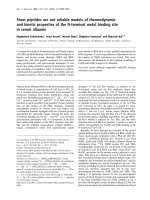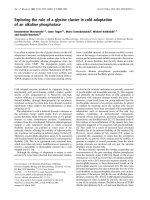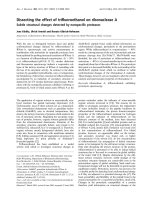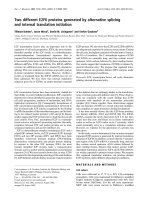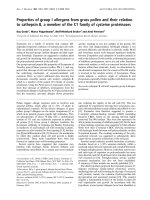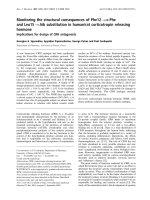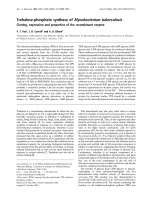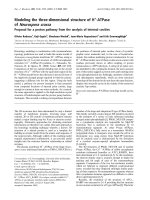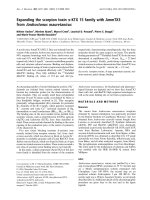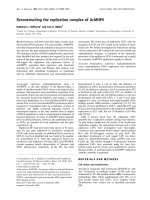Báo cáo Y học: When the embryonic genome flexes its muscles Chromatin and myogenic transcription regulation ppt
Bạn đang xem bản rút gọn của tài liệu. Xem và tải ngay bản đầy đủ của tài liệu tại đây (141.14 KB, 6 trang )
MINIREVIEW
When the embryonic genome flexes its muscles
Chromatin and myogenic transcription regulation
Ralph A. W. Rupp
1
, Nishant Singhal
1
and Gert Jan C. Veenstra
2
1
Adolf-Butenandt-Institut, Department of Molecular Biology, Mu
¨
nchen, Germany;
2
Department of Molecular Biology,
Nijmegen Centre for Molecular Life Sciences, University of Nijmegen, the Netherlands
During the development of multicellular organisms, both
transient and stable gene expression patterns have to be
established in a precisely orchestrated sequence. Evidence
from diverse model organisms indicates that this epigenetic
program involves not only transcription factors, but also the
local structure, composition, and modification of chromatin,
which define and maintain the accessibility and transcrip-
tional competence of the nucleosomal DNA template. A
paradigm for the interdependence of development and
chromatin is constituted by the mechanisms controlling the
specification and differentiation of the skeletal muscle cell
lineage in vertebrates, which is the topic of this review.
Keywords: skeletal myogenesis; MyoD family; chromatin
remodelling; histone-acetyltransferase; histone H1.
INTRODUCTION
Following cells through development as they become
specified and differentiate into a specific cell type provides
a framework, in which developmental and chromatin
aspects of gene regulation naturally meet. The determin-
ation of cell fate involves invariably induction-dependent
changes in gene expression patterns. For the acquisition of
skeletal muscle cell identity, this involves the transcriptional
activation of the MyoD and Myf5 genes, the two early
expressed members of the myogenic bHLH transcription
factor family in vertebrates (reviewed in [1]; see Fig. 1). Not
surprisingly, many of the Ôusual suspectsÕ of embryonic
patterning signals, i.e. SHH, FGFs, TGF-bs, and Wnts,
have been implicated as potential activators and repressors,
although a direct link between any of these pathways and
the myogenic genes has yet to be established. A question of
general importance for embryonic induction arises from the
pleiotropic nature of these signals: how do they specify the
stage- and tissue-specific expression patterns of the myo-
genic genes, given their functional cooperation at many
different times and places in the embryo? As discussed here,
insights from several vertebrate species point to epigentic
marks and chromatin as a pivotal regulator of transcrip-
tional competence. This is evident from reports showing that
regulatory elements of the myf5 and myoD genes from
several vertebrate species require a chromosomal context for
proper function [2–4] (A. Oho, L. Xiao & R. Rupp,
unpublished observation), but this theme extends also
beyond the induction of these two master regulatory genes.
Once expressed, MyoD and Myf5 protein will drive
myoblasts toward cell cycle exit and promote terminal
differentiation by activating downstream target genes such
as p21, myogenin and members of the Mef-2 protein family
(Fig. 1). How fast and efficient this goal is achieved depends
on extracellular signals, which control the activity of the
myogenic proteins through covalent modifications and a
multitude of protein–protein interactions (reviewed in
[1,6,7]). Among the interaction partners, particularly
MyoD, an increasing number of chromatin modifying and
remodelling enzymes are found, which can both restrict and
potentiate the activities of the muscle regulatory proteins. In
the following, we will discuss regulatory functions of
chromatin structure and modifications in prospective muscle
cells, as these progress through their normal development.
MYOGENESIS AND DNA METHYLATION
The most abundant modification of vertebrate genomes is
methylation of cytosine at CG dinucleotides. DNA methy-
lation is dynamically regulated during embryonic develop-
ment, and plays a role in the stable repression of gene
expression through nucleosomal histone deacetylation, as in
the examples of X-chromosome inactivation, silencing of
transposable elements and genomic imprinting in mammals
(reviewed by [8,9]). Vertebrate genomes contain at least five
genes (MeCP2, MBD1–4) with a highly related methyl-CpG
binding domain (MBD). All MBD proteins, except MBD4,
have been found associated with histone deacetylases
(reviewed in [10,11]), providing a mechanistic link between
DNA methylation, chromatin and repression.
A potential link between methylation and myogenesis
was provided early on by the observation that 5-azacytidine
treatment (which inhibits CpG methylation) converts 10T1/
2 mouse embryonic fibroblasts at high frequency to muscle
Correspondence to R. A. W. Rupp, Adolf-Butenandt-Institut,
Department of Molecular Biology, Schillerstr. 44, D-80336 Mu
¨
nchen,
Germany.
Fax: + 49 89 5996440, Tel.: + 49 89 5996438,
E-mail:
Abbreviations: HAT, histone acetyltransferases; HDAC, histone
deacetylase.
Dedication: This Minireview Series is dedicated to Dr Alan Wolffe,
deceased 26 May 2001.
(Received 15 November 2001, revised 19 February 2002,
accepted 18 March 2002)
Eur. J. Biochem. 269, 2294–2299 (2002) Ó FEBS 2002 doi:10.1046/j.1432-1033.2002.02885.x
[12]. This observation led to the cloning of MyoD [13].
Whether transcription of this master control gene is
normally regulated by DNA-methylation has remained
controversial, because the CpG island of the MyoD
promoter is constitutively unmethylated in vivo [14]. How-
ever, this possibility has been revived by the identification of
a conserved distal enhancer element, which mediates the
primary induction of the human and mouse myoD genes in
development [3,15], and by the subsequent finding that this
enhancer undergoes a regulated demethylation in some
somitic cells, before the myoD gene is activated [16].
Through this transition, the methylation status of the distal
enhancer becomes tightly correlated with myoD transcrip-
tion, i.e. completely unmethylated in myogenic cells but
significantly methylated in nonmuscle cells and tissues.
Reporter genes, in which the CpG dinucleotides of this
enhancer were mutated, expressed normally in transgenic
mice, indicating that methylation at the distal enhancer is
not required to prevent precocious or ectopic MyoD
transcription in the mouse [16]. Instead, the authors
proposed that the regulated demethylation could imprint
the distal enhancer for subsequent induction by growth
factor signals. Linker scanner mutations have identified
functionally important subelements within the distal MyoD
enhancer [17]. Once the corresponding trans-acting factors
are known, it can be tested, whether their functions depend
on the methylation (and acetylation?) status of the enhancer
element. In Xenopus, the coding region of the myoD gene is
constitutively hypomethylated during larval development, a
feature that myoD shares with a comparatively small
fraction of the otherwise constitutively hypermethylated
frog genome [18]. This hypomethylated state of the XmyoD
gene may contribute to a short period of ubiquitous MyoD
expression at the midblastula transition, which precedes the
local stabilization and up-regulation of myoD transcription
in prospective myoblasts at the beginning of gastrulation
[19]. The subsequent silencing of this ubiquitous myoD
transcription in nonmuscle cells occurs without de novo
methylation [18]. Whether the DNA methylation patterns
of critical regulatory elements of frog myoD undergo
developmental changes, as in the mouse, remains to be seen.
H1 linker histones and myogenic competence
Linker histones and a number of other proteins bind to
internucleosomal or linker DNA. The high mobility group
proteins HMG1 and HMG2, for example, share a similar
structural role in binding to linker DNA with several
variants of linker histones [20], but differ in their affinity for
nucleosomal DNA and their ability to repress transcription
of the genes with which they associate [21]. One of the linker
histone variants, referred to as H1oo or B4, is expressed
specifically in the oocyte and early embryo [22,23], and has
been shown in Xenopus to be required for myogenic
competence during early embryogenesis [24].
Xenopus MyoD is expressed at low levels at the late
blastula stage, which requires developmentally regulated
translation of maternal TBP RNA [25], but may require
other regulatory events as well. Subsequently, MyoD and
Myf5 expression are induced by secreted growth factors of
the TGF-b, Wnt- and FGF-families [26] in prospective
muscle, when mesoderm forms at the onset of gastrulation.
This in contrast to mammals, in which early myogenic gene
expression is coupled to somitogenesis. The timing of MyoD
induction in Xenopus embryonic explant assays is largely
independent from the timepoint of inducer application [26].
An independent mechanism ensures that MyoD transcrip-
tion can only be induced until the midgastrula stage,
although signalling pathways, for example that of activin
(a TGF-b family member and potent muscle inducer in
Xenopus), remain functional [24]. The loss of MyoD-indu-
cibility coincides precisely with the disappearance of both
muscle-forming competence and general mesodermal com-
petence. Together, these observations describe a window of
opportunity to induce MyoD transcription of less than two
hours, which is a reflection of chromosomal epigenetic state
of the MyoD locus [26]. Indeed, the ability to induce MyoD
is under the control of linker histone proteins, which act as
transcriptional inhibitors of MyoD induction [24].
The chromatin of early frog embryos undergoes major
transitions in chromatin structure from cleavage to neurula
stages, including a gradual replacement of a maternal linker
histone variant (known as B4 or H1M) by somatic H1
protein subtypes after the midblastula transition [27].
Delaying the accumulation of somatic H1 protein by
antisense methodology prolonged the period of myoD
induciblility and muscle-forming competence, while overex-
pression of somatic (but not the maternal) H1 variants had
the opposite effect. Thus, accumulation of somatic H1
protein is rate-limiting for the timepoint, at which embry-
onic cells loose competence to enter the myogenic program.
In vivo, H1A was shown both to control the number of
Myf5
MRF 4/
Myogenin
MEF-2
Muscle Structural
Genes
Induction
Determination Differentiation
?
?
Transcriptional
Competence
(H1-Silencing
De-Methylation)
Chromatin Remodeling
(BRM/BRG-1)
SHH
TGF-ß
Wnt/ß-Catenin
G0 Arrest
Acetylation/
Deacetylation
(p300/ P/CAF
HDAC-1/N-Co-R)
Chromatin
Remodeling
(BRM/BRG-1)
Mesodermal
Precursor Cell
Myozyte
MyotubeMyoblast
?
MyoD
Fig. 1. Simplified diagram of the skeletal
muscle differentiation program in vertebrates.
Solid arrows symbolize progression through
development or genetic epistasis, respectively.
Dashed arrows define epigenetic inputs; the
question marks indicate either unclear mech-
anisms (myoD/myf5 inductions) or potential
contribution (b-catenin/Brm interaction) for
the transcriptional induction of myoD and
myf5 genes.
Ó FEBS 2002 Muscle chromatin (Eur. J. Biochem. 269) 2295
MyoD-positive cells, and to prevent ectopic induction of
MyoD transcription in the neural plate, apparently
uncoupling some redundancy between mesodermal and
neural induction processes [24]. In addition, somatic H1A
represses the oocyte-specific 5S RNA genes from the late
blastula stage on, and prevents precocious activation of the
H1° gene, an H1 variant found in differentiated somatic
cells [28,29].
Mounting evidence from diverse organisms describes H1
linker histones as gene-specific regulators of transcription
[24,30], but many aspects of its function are still unknown.
Overexpression of H1 subtypes can have selective effects on
gene expression, due to differences in the central globular
domain [31], and phosphorylation of H1 is implicated as a
necessary step in the hormone dependent activation of the
MMTV-LTR promoter by the glucocorticoid receptor [32].
So far, all H1 functions described in Xenopus require only
the globular DNA-binding domain of H1, but not the
charged N- and C-terminal tails, through which H1 affects
higher-order chromatin structure [33]. Thus, the mechanism
whereby histone H1 restricts induction of myoD, is through
stabilization of nucleosome cores [30] and, possibly, inter-
ference with nucleosome remodelling by SWI/SNF com-
plexes [34]. The target of histone H1 in frog myogenesis
could either be the MyoD locus itself, or the locus of an
upstream regulator. Identification of the transcription
factors inducing MyoD transcription will allow distinction
between these possibilities.
ACETYLATION AND MYOGENIC
REGULATORS
Histone acetyltransferases (HATs) such as p300/CBP,
P/CAF and GCN5/2 are integrators for transcriptional
regulation, which play important roles in development [35].
Likewise, histone deacetylases (HDACs) [36] also play
important biological roles (reviewed in [37]). Both enzyme
families have been shown to regulate myogenic protein
activities, in particular that of MyoD (see Fig. 2).
A first link between HATs and myogenesis was estab-
lished by the finding that p300/CBP and P/CAF function as
coactivators of MyoD [38,39]. This involves direct acetyla-
tion of MyoD protein through both P/CAF [40] and p300
[41] at conserved lysine residues near the basic region of
MyoD. This modification increases both MyoD’s DNA
binding activity [42] and its affinity for p300/CBP [43].
Preventing acetylation of MyoD by mutating these lysines
impaired the ability of MyoD to transactivate target genes
and induce myogenic conversion [42], implicating MyoD
acetylation as an important differentiation promoting event.
However, the situation is more complicated because MyoD
acetylation and association with p300 and P/CAF has been
observed only in postmitotic, differentiating cells. In prolif-
erating cells, MyoD is associated with the histone deacety-
lase HDAC-1, either by direct interaction or by recruitment
through the nuclear receptor corepressor N-CoR [44,45].
HDAC-1 can deacetylate MyoD protein in vitro,andits
enzymatic activity is required to silence endogenous MyoD
target genes, such as p21, in proliferating cells. These in vitro
studies suggest that the transcriptional activity of MyoD is
temporally controlled during myogenesis through interac-
tions with HDAC-1/N-CoR or p300/PCAF. The equilib-
rium between these complexes appears to be shifted by
phosphorylation of MyoD protein through cdk1 and cdk2
[7], with HATs associating with underphosphorylated
MyoD protein [44,46]. Unfortunately, not enough is known
about the temporal correlation between Myf5/MyoD-
mediated gene activation, cell cycle exit, and muscle
differentiation to know, whether a quantitative switch from
HDAC- to HAT-containing myogenic protein complexes
occurs in vivo, or whether both complexes coexist in a
dynamic equilibrium controlled by extracellular signals and
cell cycle regulators [7]. Because the binding-domains for
p300/CBP and HDAC-1/N-CoR do not overlap on MyoD
(see Fig. 2), it is formally possible that both enzyme classes
could be associated with MyoD simultaneously. In fact, this
could contribute to the observed block of MyoD protein
function by the HDAC-inhibitor TSA in early embryonic
frog cells [47]. This issue relates also to the question, whether
Myf5/MyoD corepressor complexes function as repressors
during the establishment of muscle cell identity, which is an
issue of controversy in the field [48,49].
A regulated transition between HAT- and HDAC-
interactions has been reported for MEF-2 proteins. Mem-
bers of this protein family lack myogenic activity, but are
essential potentiators of myogenic bHLH protein activities
during muscle differentiation [50]. Specifically, class II
HDACs 4 and 5 bind and inhibit the transactivation
activity of MEF-2 [51,52]. Interestingly, the MEF-2/HDAC
complex is sensitive to calcium-calmodulin-dependent pro-
tein kinsase (CamK) activity, which mediates the muscle
differentiation promoting effect of Insulin-like growth
factor 1 [53]. Increased CamK activity leads to phosphory-
lation of HDAC5 on two serine residues, which induces
binding of the chaperone protein 14-3-3, activation of the
HDAC5 nuclear export signal, and consequent export of
the transcriptional repressor to the cytoplam [54]. HDAC-
free nuclear MEF-2 proteins interact instead with GRIP-1,
3181 60 162
Transactivation
Domain
P 300 - P/CAF
Acetylated residues
124
P300/CBP
interaction domain
Activation of silent genes
Chromatin remodelling
K K K
99 101 102
218 26963 99
102
Helix IIIHelix Loop HelixBasicCys/His
DNA Binding & Dimerization Domain
Activation of silent genes
Chromatin remodelling
HDAC-1/NCo-R
interaction domain
Fig. 2. MyoD’s toolbox for changing chromatin structure. Functional subdomains are indicated as segments, with numbers referring to amino-acid
residues of mouse MyoD protein. Only interactions between MyoD and chromatin modifying enzymes are shown. For further information about
myoD protein partners refer to the references [1,6,7].
2296 R. A. W. Rupp et al. (Eur. J. Biochem. 269) Ó FEBS 2002
a transcriptional coactivator with intrinsic HAT-activity,
which is required for MEF-2C dependent gene expression
and skeletal muscle differentiation [55]. These studies
establish a mechanistic model for how extracellular cues
control progression of muscle differentiation.
There may be many targets for the enzymatic activities of
the various HAT- and HDAC-complexes with myogenic
regulators, but nucleosomal histones are certainly among
them. For instance, histone octamers at the XMyoD
promoter are hyperacteylated in frog oocytes by MyoD/
P300/PCAF-dependent transactivation (S. Ait-Si-Ali,
A. Wolffe and R. Rupp, unpublished results), and the
nucleosomes at the regulatory sites of the myogenin and
MCK genes, which are bound by MyoD and MEF-2 family
members, shift from a hypo- to a hyper-acteylated state
during muscle differentiation [51]. Thus, either directly or
indirectly, the core myogenic regulators induce modifica-
tions of the local chromatin infrastructure through recruit-
ment of HAT- and possibly HDAC-enzymes in the course
of myogenesis.
CHROMATIN REMODELING IN MUSCLE
DIFFERENTIATION
Chromatin structure and nucleosomal positions are subject
to dynamic regulation in the cell nucleus. This nucleosome
remodeling can either facilitate transcription or repress it,
depending on where the nucleosomes are moved relative to
important regulatory regions of specific genes. A key role in
shuffling nucleosomes is played by nucleosomal ATPases of
the SWI/SNF superfamily (reviewed in [56]). By regulating
chromatin structure, nucleosomal ATPases play important
roles in differentiation and development. Here we will
briefly review the contribution of these enzymes to myo-
genesis.
In vivo, Myf5 and MyoD have to initiate gene transcrip-
tion at many previously silent loci. MyoD utilizes two
domains (see Fig. 2) to remodel the repressive chromatin
structure over regulatory regions of target genes such as
myogenin or muscle creatine kinase [57]. Repressors of
muscle differentiation, such as TGF-b, bFGF and sodium
butyrate, inhibit MyoD-mediated transactivation only
before, but not after, chromatin remodelling. The ability
to remodel chromatin is therefore a pivotal aspect of MyoD
function, which may be regulated in vivo by extracellular
signals.
Interestingly, myogenin was significantly less efficient
than MyoD or Myf5 in initiating endogenous muscle gene
expression. Domain-swap experiments between MyoD and
myogenin, both members of the myogenic bHLH family of
transcription factors, revealed that sequence divergence in a
C-terminal domain (i.e. Ôhelix IIIÕ; Fig. 2) is responsible for
this difference [58]. Helix III of MyoD contributes to
chromatin remodelling, while in myogenin this domains acts
as a general transcriptional activation domain. The func-
tional specialization of helix III sequences provides a
molecular basis for the apparent distinction between
specification (MyoD/Myf5) and differentiation (myogenin)
functions within the myogenic bHLH gene family [58].
Recently, dominant-negative variants of human Brahma
(Brm) or Brahma-related gene-1 (BRG-1) proteins, related
ATPase subunits of two mammalian SWI/SNF complexes,
were shown to block MyoD-mediated chromatin-remodel-
ling, transactivation and muscle differentiation in cell lines
[59]. Interestingly, while activation of all muscle-specific
regulatory or structural genes was inhibited, the ability of
MyoD to cause cell-cycle arrest through activation of cdk
inhibitor p21, cyclin D3 and the retinoblastoma protein was
unaffected by the dominant-negative variants [60]. This may
reflect differences in chromatin structure of cell cycle
regulatory genes vs. muscle differentiation genes, or indicate
different activation requirements by MyoD protein.
Consistent with the latter possibility, the basic region of
MyoD, which is required for the activation of muscle
specific genes, is dispensable for MyoD-mediated cell cycle
arrest [61]. Together, the data suggest that MyoD (and
probably Myf5) recruit mammalian SWI/SNF complexes
to initiate target gene transcription. However, formal proof
of a physical interaction between MyoD and Brm/Brg-1
containing chromatin remodelling complexes is still missing,
as well as formal genetic evidence for an involvement of
hSWI/SNF complexes in myogenesis. Indeed, the latter may
not be easy to obtain, given that gene knock-outs for several
components of Brm/BRG-1 complexes, including BRG-1
[62], SNF5/INI1 [63–65], and Srg3 [66], result in early
embryonic lethality.
MyoD induced chromatin remodelling is not restricted to
promoter regions, but has been observed at several kb
distance from the promoter and in the absence of tran-
scription. Thus, it could provide a priming function for the
activation of late muscle genes by factors like myogenin,
which cannot efficiently remodel chromatin [57]. Precedence
for a preconfiguration of chromatin structure, which occurs
before transcriptional activation, has been reported for
example for the lysozyme gene in myeloid cells [67], and for
the b-globin gene in erythrocytes [68]. Priming by SWI/SNF
complexes may even apply to the myogenic determination
genes themselves. It was recently shown that b-catenin
interacts directly with BRG-1 to promote target gene
activation in response to Wnt ligands [69], one of the
presumed inducers of Myf5 and MyoD transcription [1].
b-Catenin binds to Tcf transcription factors, which can also
serve as docking sites for corepressors [70]. Indeed, a distal
Tcf binding site mediates repression of Myf5 in nonmuscle
mesoderm in Xenopus, i.e. in regions devoid of Wnt
signaling [5]. Although the mechanism of repression is not
known in this case, evidence from Drosophila indicates that
some Wingless target genes are silenced in the absence of the
Wg ligand through a specialized Brm chromatin remodel-
ling complex, characterized by the conserved Osa protein
[71]. It remains to be seen whether vertebrates contain an
equivalent remodelling complex to repress Wnt target genes
such as Xmyf5, or whether this involves the groucho/
HDAC corepressor complexes, which interact with Tcf
proteins in the absence of Wnt signalling [70].
CONCLUSIONS
We have limited this review to interactions between the core
network of myogenic regulatory proteins and chromatin
modifying enzymes. Correlating the genetic blueprint of
skeletal myogenesis with these epigentic regulatory inputs
reveals that embryonic cells need to modify the chromatin
structure in many ways in order to become muscle (Fig. 1).
Additional, pivotal control levels, such as the interplay
between the myogenic bHLH regulators and the cell cycle
Ó FEBS 2002 Muscle chromatin (Eur. J. Biochem. 269) 2297
machinery, have not been elaborated here. As exemplified
by the retinoblastoma protein, whose antiproliferative
activity depends at least in part on SWI/SNF and HDAC
protein functions [7], chromatin would again emerge as one
important interface of regulation. Given the rapid advances
of the field in recent years, it can be expected that the tuning
of the chromatin fibre will soon be recognized as a general
and essential aspect of developmental gene regulation.
ACKNOWLEDGEMENTS
This review is dedicated to the late Dr Alan P. Wolffe, whose scientific
passion, insight and vision constituted an important motor for the
chromatin field.
REFERENCES
1. Buckingham, M. (2001) Skeletal muscle formation in vertebrates.
Curr. Opin. Genet. Develop. 11, 440–448.
2. Tapscott, S.J., Lassar, A.B. & Weintraub, H. (1992) A novel
myoblast enhancer element mediates MyoD transcription. Mol.
Cell. Biol. 12, 4994–5003.
3. Goldhamer, D.J., Brunk, B.P., Faerman, A., King, A., Shani, M.
& Emerson, C.P. Jr (1995) Embryonic activation of the myoD gene
is regulated by a highly conserved distal control element. Devel-
opment 121, 637–649.
4. Reference withdrawn.
5. Yang,J.,Mei,W.,Otto,A.,Xiao,L.,Tao,Q.,Geng,X.,Rupp,
R.A.W. & Ding, X. (2001) Repression through a distal TCF-3
binding site restricts Xenopus myf-5 expression in gastrula meso-
derm. Mech. Develop.,inpress.
6. Yun, K. & Wold, B. (1996) Skeletal muscle determination and
differentiation: story of a core regulatory network and its context.
Curr. Opin. Cell Biol. 8, 877–889.
7. Kitzmann, M. & Fernandez, A. (2001) Crosstalk between cell
cycle regulators and the myogenic factor MyoD in skeletal myo-
blasts. Cell. Mol. Life Sci. 58, 571–579.
8. Bird, A. (2002) DNA methylation patterns and epigenetic mem-
ory. Genes Develop. 16, 6–21.
9. Reik, W. & Walter, J. (2001) Genomic imprinting: parental
influence on the genome. Nat. Rev. Genet. 2, 21–32.
10. Ballestar, E. & Wolffe, A.P. (2001) Methyl-CpG-binding proteins
– targeting specific gene repression. Eur. J. Biochem. 268,1–6.
11. Wade, P.A. (2001) Methyl CpG binding proteins: coupling chro-
matin architecture to gene regulation. Oncogene 20, 3166–3173.
12. Taylor, S.M. & Jones, P.A. (1982) Changes in phenotypic
expression in embryonic and adult cells treated with 5-azacy-
tifdine. J. Cell Physiol. 111, 187–194.
13. Davis, R.L., Weintraub, H. & Lassar, A.B. (1987) Expression of a
single transfected cDNA converts fibroblasts to myoblasts. Cell
51, 987–1000.
14. Jones, P.A., Wolkowicz, M.J., Harrington, M.A. & Gonzales, F.
(1990) Methylation and expression of the Myo D1 determination
gene. Philos. Trans. R. Soc. London Series B: Biol. Sci. 326,277–
284.
15. Kablar, B., Krastel, K., Ying, C., Tapscott, S.J., Goldhamer, D.J.
& Rudnicki, M.A. (1999) Myogenic determination occurs
independently in somites and limb buds. Dev. Biol. 206, 219–231.
16. Brunk, B.P., Goldhamer, D.J. & Emerson, C.P.J. (1996) Regu-
lated demethylation of the myoD distal enhancer during skeletal
myogenesis. Dev. Biol. 177, 490–503.
17. Kucharczuk, K.L., Love, C.M., Dougherty, N.M. & Goldhamer,
D.J. (1999) Fine-scale transgenic mapping of the MyoD core
enhancer: MyoD is regulated by distinct but overlapping
mechanisms in myotomal and non-myotomal muscle lineages.
Development 126, 1957–1965.
18. Veenstra, G.J.C. & Wolffe, A.P. (2001) Constitutive genomic
methylation during embryonic development of Xenopus. Biochim.
Biophys. Acta 1521, 39–44.
19. Rupp, R.A.W. & Weintraub, H. (1991) Ubiquitous MyoD tran-
scription at the midblastula transition precedes induction-depen-
dent MyoD expression in presumptive mesoderm of X. laevis. Cell
65, 927–937.
20. Nightingale, K., Dimitrov, S., Reeves, R. & Woolfe, A.P. (1996)
Evidence for a shared structural role for HMG1 and linker his-
tones B4 and H1 in organizing chromatin. EMBO J. 15, 548–561.
21. Ura, K., Nightingale, K. & Wolffe, A.P. (1996) Differential
association of HMG1 and linker histones B4 and H1 with
dinucleosomal DNA: structural transitions and transcriptional
repression. EMBO J. 15, 4959–4969.
22. Smith,R.C.,Dworkin-Rastl,E.&Dworkin-Rastl,M.D.(1988)
Expression of a histone H1-like protein is restricted to early
Xenopus development. Genes Dev. 2, 1284–1295.
23. Tanaka, M., Hennebold, J.D., Macfarlane, J. & Adashi, E.Y.
(2001) A mammalian oocyte-specific linker histone gene H1oo:
homology with the genes for the oocyte-specific cleavage stage
histone (cs-H1) of sea urchin and the B4/H1M histone of the frog.
Development 128, 655–664.
24. Steinbach, O.C., Wolffe, A.P. & Rupp, R.A.W. (1997) Somatic
linker histones cause loss of mesodermal competence in Xenopus.
Nature 389, 395–399.
25. Veenstra, G.J.C., Weeks, D.L. & Wolffe, A.P. (2000) Distinct roles
for TBP and TBP-like factor in early embryonic gene transcription
in Xenopus. Science 290, 2312–2315.
26. Steinbach, O.C.A.U., Authaler, A. & Rupp, R.A.W. (1998)
Temporal restriction of MyoD induction and autocatalysis during
Xenopus mesoderm formation. Dev. Biol. 202, 280–292.
27. Dimitrov, S., Almouzni, G., Dasso, M. & Wolffe, A.P. (1993)
Chromatin transitions during early Xenopus embryogenesis:
changes in histone H4 acetylation and in linker histone type. Dev.
Biol. 160, 214–227.
28. Bouvet, P., Dimitrov, S. & Wolffe, A.P. (1994) Specific regulation
of Xenopus chromosomal 5S rRNA gene transcription in vivo by
histone H1. Genes Dev. 8, 1147–1159.
29. Kandolf, H. (1994) The H1A histone variant is an in vivo repressor
of oocyte-type 5S gene transcription in Xenopus laevis embryos.
Proc. Natl Acad. Sci. USA 91, 7257–7260.
30. Thomas, J.O. (1999) Histone H1: location and role. Curr. Opin.
Cell Biol. 11, 312–317.
31. Brown, D.T., Gunjan, A., Alexander, B.T. & Sittman, D.B. (1997)
Differential effect of H1 variant overproduction on gene expres-
sion is due to differences in the central globular domain. Nucleic
Acids Res. 25, 5003–5009.
32. Lee, H.L. & Archer, T.K. (1998) Prolonged glucocorticoid
exposure dephosphorylates hitone H1 and inactivates the MMTV
promoter. EMBO J. 17, 1454–1466.
33. Vermaak, D., Steinbach, O.C., Dimitrov, S., Rupp, R.A.W. &
Wolffe, A.P. (1998) The globular domain of histone H1 is suffi-
cient to direct specific gene repression in Xenopus embryos. Curr.
Biol. 8, 533–536.
34. Hill, D.A. & Imbalzano, A.N. (2000) Human SWI/SNF nucleo-
some remodeling activity is partially inhibited by linker histone
H1. Biochemistry 39, 11649–11656.
35. Marmorstein, R. & Roth, S.Y. (2001) Histone acetyltransferases:
function, structure, and catalysis. Curr.Opin.Gen.Dev.11,155–
161.
36. Khochbin, S., Verdel, A., Lemercier, C. & Seigneurin-Berny, D.
(2001) Functional significance of histone deacetylase diversity.
Curr.Opin.Gen.Dev.11, 162–166.
37. Wade, P.A. (2001) Transcriptional control at regulatory check-
points by histone deacetylases: molecular connections between
cancer and chromatin. Hum. Mol. Genet. 10, 693–698.
2298 R. A. W. Rupp et al. (Eur. J. Biochem. 269) Ó FEBS 2002
38. Eckner, R., Yao, T P., Oldread, E. & Livingston, D.M. (1996)
Interaction and functional collaboration of p300/CBP and bHLH
proteins in muscle and B-cell differentiation. Genes Dev. 10, 2478–
2490.
39. Puri, P.L., Avantaggiati, M.L., Balsano, C., Sang, N., Graess-
mann, A., Giordano, A. & Levrero, M. (1997) p300 is required for
MyoD-dependent cell cycle arrest and muscle-specific gene tran-
scription. EMBO J. 16, 369–383.
40. Puri,P.L.,Sartorelli,V.,Yang,X J.,Hammamori,Y.,Ogryzko,
V.V., Howard, B.H., Kedes, L., Wang, J.Y.J., Graessmann, A.,
Nakatani, Y. & Levrero, M. (1997) Differential roles of p300 and
PCAF acetyltransferases in muscle differentiation. Mol. Cell
1, 35–45.
41. Polesskaya, A. & Harel-Bellan, A. (2001) Acetylation of MyoD by
p300 requires more than its HAT domain. J. Biol. Chem. 276,
44502–44503.
42. Sartorelli, V., Puri, P.L., Hamamori, Y., Ogryzko, V.V., Yang,
X J., Nakatani, Y., Wang, J.Y.J. & Kedes, L. (1999) Acetylation
of MyoD Directed by PCAF is necessary for the execution of the
muscle program. Mol. Cell 4, 725–734.
43. Polesskaya, A., Naguibneva, I., Duquet, A., Bengal, E., Robin, P.
& Harel-Bellan, A. (2001) Interaction between Acetylated MyoD
and the Bromodomain of CBP and/or p300. Mol. Cell. Biol. 21,
5312–5320.
44. Mal, A., Sturniolo, M., Schiltz, R.L., Ghosh, M.K. & Harter,
M.L. (2001) A role for histone deacetylase HDAC-1 in modulat-
ing the transcriptional activity of MyoD: inhibition of the myo-
genic program. EMBO J. 20, 1739–1753.
45. Bailey,P.,Downes,M.,Lau,P.,Harris,J.,Chen,S.L.,Hama-
mori,Y.,Sartorelli,V.&Muscat,G.E.O.(1999)Thenuclear
receptor corepressor N-CoR regulates differentiation: NCo-R.
Directly interacts with MyoD. Mol. Endocrinol. 13, 1155–1168.
46. Wei, Q. & Paterson, B.M. (2001) Regulation of MyoD function in
the dividing myoblast. FEBS Lett. 490, 171–178.
47. Steinbach, O.C., Wolffe, A.P. & Rupp, R.A.W. (2000) Histone
deacetylase activity is required for the induction of the MyoD
muscle cell lineage in Xenopus. Biol. Chem. 381, 1013–1016.
48. Tajbakhsh, S., Rocancourt, D. & Buckingham, M. (1996) Muscle
progenitor cells failing to respond to positional cues adopt non-
myogenic fates in myf-5 null mice. Nature 384, 266–270.
49. Williams, B.A. & Ordahl, C.P. (2000) Fate restriction in limb
muscle precursor cells precedes high-level expression of MyoD
family member genes. Development 127, 2523–2536.
50. Molkentin, J.D., Black, B.L., Martin, J.F. & Olson, E.N. (1995)
Cooperative activation of muscle gene expression by MEF2 and
myogenic bHLH proteins. Cell 83, 1125–1136.
51. Lu, J., McKinsey, T.A., Zhang, C L. & Olson, E.N. (2000)
Regulation of skeletal myogenesis by association of the MEF-2
transcription factor with class II histone deacetylases. Mol. Cell 6,
233–244.
52. Miska, E.A., Karlsson, C., Langley, E., Nielsen, S.J., Pines, J. &
Kouzarides, T. (1999) HDAC4 deacetylase associates with and
represses the MEF2 transcription factor. EMBO J. 18, 5099–5107.
53. McKinsey, T.A., Zhang, C L., Lu, J. & Olson, E.N. (2000) Sig-
nal-dependent nuclear export of a histone deacetylase regulates
muscle differentiation. Nature 408, 106–111.
54. McKinsey, T.A., Zhang, C L. & Olson, E.N. (2001) Identification
of a signal-responsive nuclear export sequence in class II histone
deacetylases. Mol. Cell. Biol. 21, 6312–6321.
55. Chen, S.L., Howhan, D.H., Hosking, B.M. & Muscat, G.E.O.
(2000) The steroid receptor coactivator, GRIP-1, is necessary for
MEF2C-dependent gene expression and skeletal muscle differ-
entiation. Genes Dev. 14, 1209–1228.
56. Varga-Weisz, P. (2001) ATP-dependent chromatin remodeling
factors: nucleosome shufflers with many missions. Oncogene 20,
3076–3085.
57. Gerber, A.N., Klesert, T.R., Bergstrom, D.A. & Tapscott, S.J.
(1997) Two domains of MyoD mediate transcriptional activation
of genes in repressive chromatin: a mechanism for lineage
determination in myogenesis. Genes Dev. 11, 436–450.
58. Bergstrom, D.A. & Tapscott, S.J. (2001) Molecular distinction
between specification and differentiation in the myogenic basic
helix-loop-helix transcription factor family. Mol. Cell. Biol. 21,
24204–22412.
59. de la Serna, I.L., Carlson, K.A. & Imbalzano, A.N. (2001)
Mammalian SWI/SNF complexes promote MyoD-mediated
muscle differentiation. Nat. Genet. 27, 187–190.
60. de la Serna, I.L., Kanaklata, R., Carlson, K.A. & Imbalzano,
A.N. (2001) MyoD can induce cell cycle arrest but not muscle
differentiation in the presence of dominant negative SWI/SNF
chromatin remodeling enzymes. J. Biol. Chem. 276, 41486–41491.
61. Sorrentino, V., Pepperkok, R., Davis, R.L., Ansorge, W. &
Philipson, L. (1990) Cell proliferation inhibited by MyoD1
independently of myogenic differentiation. Nature 345, 813–815.
62. Bultman, S., Gebuhr, T., Yee, D., La, M., Antia, C., Nicholson, J.,
Gilliam, A., Randazzo, F., Metzger, D., Chambon, P., Crabtree,
G.R. & Magnuson, T. (2000) A brg1 null mutation in the mouse
reveals functional differences among mammalian SWI/SNF
complexes. Mol. Cell 6, 1287–1295.
63. Klochendler-Yeivin, A., Fiette, L., Barra, J., Muchardt, C.,
Babinet, C. & Yaniv, M. (2000) The murine SNF5/INI1 chro-
matin remodeling factor is essential for embryonic development
and tumor suppression. EMBO Rep. 1, 500–506.
64. Roberts, C.W.M., Galusha, S.A., McMenamin, M.E., Fletcher,
C.D.M. & Orkin, S.H. (2000) Haploinsufficiency of snf5 (integrase
interactor 1) predisposes to malignant rhabdoid tumors in mice.
Proc. Natl Acad. Sci. USA 97, 13796–13800.
65. Guidi, C.J., Sands, A.T., Zambrowicz, B.P.K.T.T., Demers, D.A.,
Wenbster,W.,Smith,T.W.,Imbalzano,A.N.&Jones,S.N.
(2001) Disruption of Ini1 leads to peri-implantation lethality and
tumorigenesis in mice. Mol. Cell. Biol. 21, 3598–3603.
66. Kim, J.K., Huh, S O., Chol, H., Lee, K.S., Shin, D., Lee, C.,
Nam, J S., Kim, J., Chung, H., Lee, H.W., Park, S.D. & Seog,
R.H. (2001) Srg3, a mouse homolog of yeast SWI3, is essential for
early embryogenesis and involved in brain development. Mol.
Cell. Biol. 21, 7787–7795.
67. Kontaraki, J.C., Hen, H H., Riggs, A. & Bionifer, C. (2000)
Chromatin fine structure profiles for a developmentally regulated
gene: reorganization of the lysozyme locus before trans-activator
binding and gene expression. Genes Dev. 14, 2106–2122.
68. Jimenez,G.,Griffiths,S.D.,Ford,A.M.,Greaves,M.F.&Enver,
T. (1992) Activation of the b-globin locus control region precedes
commitment to the erythroid lineage. Proc. Natl Acad. Sci. USA
89, 10618–10622.
69. Barker, N., Hurlstone, A., Musisi, H., Miles, A., Bienz, M. &
Clevers, H. (2001) The chromatin remodelling factor Brg-1 inter-
acts with b-catenin to promote target gene activation. EMBO J.
20, 4935–4943.
70. Brantjes, H., Roose, J., van de Wetering, M. & Clevers, H. (2001)
All Tcf HMG box transcription factors interact with Groucho-
related co-repressors. Nucleic Acids Res. 29, 1410–1419.
71. Collins, R.T. & Treisman, J.E. (2000) Osa-containing Brahma
chromatin remodeling complexes are required for the repression of
Wingless target genes. Genes Dev. 14, 3140–3152.
Ó FEBS 2002 Muscle chromatin (Eur. J. Biochem. 269) 2299
